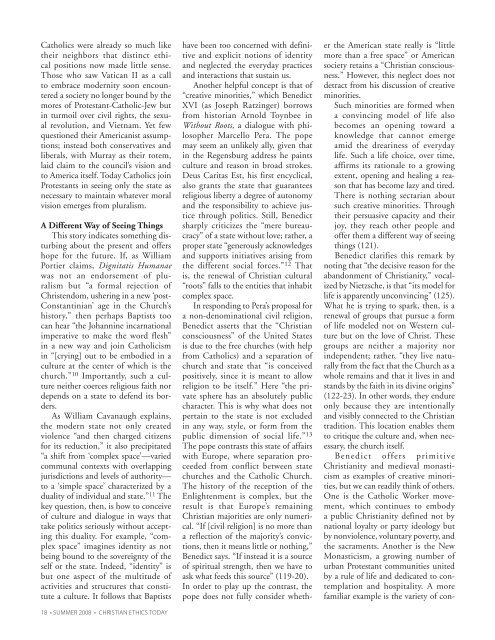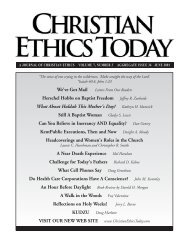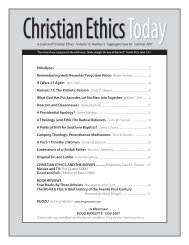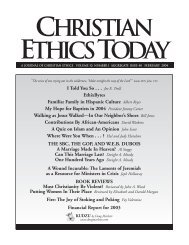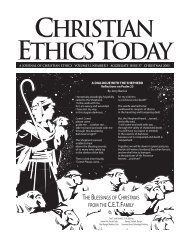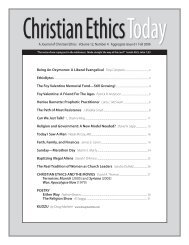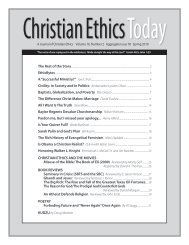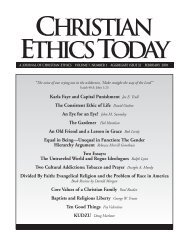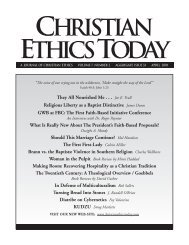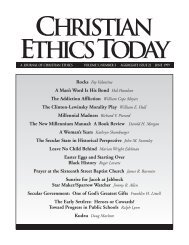Red-Letter Christians, An Emerging Evangelical Center, And Public ...
Red-Letter Christians, An Emerging Evangelical Center, And Public ...
Red-Letter Christians, An Emerging Evangelical Center, And Public ...
Create successful ePaper yourself
Turn your PDF publications into a flip-book with our unique Google optimized e-Paper software.
Catholics were already so much like<br />
their neighbors that distinct ethical<br />
positions now made little sense.<br />
Those who saw Vatican II as a call<br />
to embrace modernity soon encountered<br />
a society no longer bound by the<br />
mores of Protestant-Catholic-Jew but<br />
in turmoil over civil rights, the sexual<br />
revolution, and Vietnam. Yet few<br />
questioned their Americanist assumptions;<br />
instead both conservatives and<br />
liberals, with Murray as their totem,<br />
laid claim to the council’s vision and<br />
to America itself. Today Catholics join<br />
Protestants in seeing only the state as<br />
necessary to maintain whatever moral<br />
vision emerges from pluralism.<br />
A Different Way of Seeing Things<br />
This story indicates something disturbing<br />
about the present and offers<br />
hope for the future. If, as William<br />
Portier claims, Dignitatis Humanae<br />
was not an endorsement of pluralism<br />
but “a formal rejection of<br />
Christendom, ushering in a new ‘post-<br />
Constantinian’ age in the Church’s<br />
history,” then perhaps Baptists too<br />
can hear “the Johannine incarnational<br />
imperative to make the word flesh”<br />
in a new way and join Catholicism<br />
in “[crying] out to be embodied in a<br />
culture at the center of which is the<br />
church.” 10 Importantly, such a culture<br />
neither coerces religious faith nor<br />
depends on a state to defend its borders.<br />
As William Cavanaugh explains,<br />
the modern state not only created<br />
violence “and then charged citizens<br />
for its reduction,” it also precipitated<br />
“a shift from ‘complex space’—varied<br />
communal contexts with overlapping<br />
jurisdictions and levels of authority—<br />
to a ‘simple space’ characterized by a<br />
duality of individual and state.” 11 The<br />
key question, then, is how to conceive<br />
of culture and dialogue in ways that<br />
take politics seriously without accepting<br />
this duality. For example, “complex<br />
space” imagines identity as not<br />
being bound to the sovereignty of the<br />
self or the state. Indeed, “identity” is<br />
but one aspect of the multitude of<br />
activities and structures that constitute<br />
a culture. It follows that Baptists<br />
<br />
have been too concerned with definitive<br />
and explicit notions of identity<br />
and neglected the everyday practices<br />
and interactions that sustain us.<br />
<strong>An</strong>other helpful concept is that of<br />
“creative minorities,” which Benedict<br />
XVI (as Joseph Ratzinger) borrows<br />
from historian Arnold Toynbee in<br />
Without Roots, a dialogue with philosopher<br />
Marcello Pera. The pope<br />
may seem an unlikely ally, given that<br />
in the Regensburg address he paints<br />
culture and reason in broad strokes.<br />
Deus Caritas Est, his first encyclical,<br />
also grants the state that guarantees<br />
religious liberty a degree of autonomy<br />
and the responsibility to achieve justice<br />
through politics. Still, Benedict<br />
sharply criticizes the “mere bureaucracy”<br />
of a state without love; rather, a<br />
proper state “generously acknowledges<br />
and supports initiatives arising from<br />
the different social forces.” 12 That<br />
is, the renewal of Christian cultural<br />
“roots” falls to the entities that inhabit<br />
complex space.<br />
In responding to Pera’s proposal for<br />
a non-denominational civil religion,<br />
Benedict asserts that the “Christian<br />
consciousness” of the United States<br />
is due to the free churches (with help<br />
from Catholics) and a separation of<br />
church and state that “is conceived<br />
positively, since it is meant to allow<br />
religion to be itself.” Here “the private<br />
sphere has an absolutely public<br />
character. This is why what does not<br />
pertain to the state is not excluded<br />
in any way, style, or form from the<br />
public dimension of social life.” 13<br />
The pope contrasts this state of affairs<br />
with Europe, where separation proceeded<br />
from conflict between state<br />
churches and the Catholic Church.<br />
The history of the reception of the<br />
Enlightenment is complex, but the<br />
result is that Europe’s remaining<br />
Christian majorities are only numerical.<br />
“If [civil religion] is no more than<br />
a reflection of the majority’s convictions,<br />
then it means little or nothing,”<br />
Benedict says. “If instead it is a source<br />
of spiritual strength, then we have to<br />
ask what feeds this source” (119-20).<br />
In order to play up the contrast, the<br />
pope does not fully consider wheth-<br />
er the American state really is “little<br />
more than a free space” or American<br />
society retains a “Christian consciousness.”<br />
However, this neglect does not<br />
detract from his discussion of creative<br />
minorities.<br />
Such minorities are formed when<br />
a convincing model of life also<br />
becomes an opening toward a<br />
knowledge that cannot emerge<br />
amid the dreariness of everyday<br />
life. Such a life choice, over time,<br />
affirms its rationale to a growing<br />
extent, opening and healing a reason<br />
that has become lazy and tired.<br />
There is nothing sectarian about<br />
such creative minorities. Through<br />
their persuasive capacity and their<br />
joy, they reach other people and<br />
offer them a different way of seeing<br />
things (121).<br />
Benedict clarifies this remark by<br />
noting that “the decisive reason for the<br />
abandonment of Christianity,” vocalized<br />
by Nietzsche, is that “its model for<br />
life is apparently unconvincing” (125).<br />
What he is trying to spark, then, is a<br />
renewal of groups that pursue a form<br />
of life modeled not on Western culture<br />
but on the love of Christ. These<br />
groups are neither a majority nor<br />
independent; rather, “they live naturally<br />
from the fact that the Church as a<br />
whole remains and that it lives in and<br />
stands by the faith in its divine origins”<br />
(122-23). In other words, they endure<br />
only because they are intentionally<br />
and visibly connected to the Christian<br />
tradition. This location enables them<br />
to critique the culture and, when necessary,<br />
the church itself.<br />
Benedict offers primitive<br />
Christianity and medieval monasticism<br />
as examples of creative minorities,<br />
but we can readily think of others.<br />
One is the Catholic Worker movement,<br />
which continues to embody<br />
a public Christianity defined not by<br />
national loyalty or party ideology but<br />
by nonviolence, voluntary poverty, and<br />
the sacraments. <strong>An</strong>other is the New<br />
Monasticism, a growing number of<br />
urban Protestant communities united<br />
by a rule of life and dedicated to contemplation<br />
and hospitality. A more<br />
familiar example is the variety of con-


